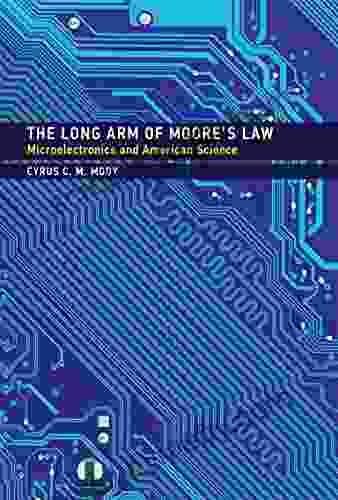The Long Arm of Moore's Law: A Technological Revolution Shaping Our World

In the realm of technological advancement, few principles have had such a profound and enduring impact as Moore's Law. First proposed in 1965 by Gordon Moore, co-founder of Intel, this remarkable law has predicted the exponential growth of computing power, leading to a technological revolution that has transformed our world.
The Essence of Moore's Law
Moore's Law states that the number of transistors on an integrated circuit doubles approximately every two years, leading to a corresponding increase in processing power. This relentless doubling has been driven by miniaturization, as manufacturers have packed an ever-increasing number of transistors into smaller and smaller spaces.
4.5 out of 5
| Language | : | English |
| File size | : | 2071 KB |
| Text-to-Speech | : | Enabled |
| Screen Reader | : | Supported |
| Enhanced typesetting | : | Enabled |
| Word Wise | : | Enabled |
| Print length | : | 364 pages |

Impact on Modern Civilization
The impact of Moore's Law has been pervasive, touching every aspect of modern life. From the personal computers and smartphones we use daily to the sophisticated medical devices and scientific instruments that advance our understanding of the world, technological advancements have become an indispensable part of our society.
- Communication: The miniaturization of transistors has enabled the development of powerful mobile phones and the global expansion of the internet, connecting people and information across vast distances.
- Healthcare: Moore's Law has revolutionized medical diagnostics and treatments. Advanced imaging techniques, such as MRI and CT scans, provide detailed insights into the human body, while miniaturized medical devices allow for less invasive procedures.
- Transportation: From self-driving cars to traffic management systems, Moore's Law has paved the way for safer and more efficient transportation. Artificial intelligence and sensors enable vehicles to navigate complex environments and communicate with each other in real-time.
Implications for the Future
As Moore's Law continues to hold true, we can expect even more profound technological advancements in the years to come. Nanotechnology, quantum computing, and artificial intelligence are just a few of the transformative technologies that are poised to shape our future.
- Artificial Intelligence: The exponential growth in computing power will further fuel the development of artificial intelligence (AI) systems. AI algorithms are already used in various applications, from image recognition to language translation, and their capabilities will continue to expand.
- Energy Efficiency: Miniaturization and improved transistor design are leading to more energy-efficient computing devices. This will be crucial for sustainable development and the reduction of our carbon footprint.
- Personalized Medicine: Moore's Law is enabling the development of personalized medicine, where treatments are tailored to an individual's genetic profile and health history. This will lead to more effective and targeted healthcare interventions.
Challenges and the Future of Moore's Law
While Moore's Law has been remarkably consistent, it is not without its challenges. As transistors approach atomic dimensions, further miniaturization becomes increasingly difficult. Researchers are exploring alternative technologies, such as 3D chip stacking and novel materials, to extend the reach of Moore's Law.
Furthermore, the environmental impact of chip manufacturing and the potential for obsolescence in rapidly evolving technologies raise important questions about the sustainability and ethical implications of our technological progress.
Embracing the Long Arm of Moore's Law
The Long Arm of Moore's Law is a testament to the relentless pursuit of technological innovation and its transformative impact on human civilization. As we navigate the challenges and embrace the opportunities presented by this remarkable principle, we must remain mindful of its potential implications and work towards a future where technology serves the greater good.
4.5 out of 5
| Language | : | English |
| File size | : | 2071 KB |
| Text-to-Speech | : | Enabled |
| Screen Reader | : | Supported |
| Enhanced typesetting | : | Enabled |
| Word Wise | : | Enabled |
| Print length | : | 364 pages |
Do you want to contribute by writing guest posts on this blog?
Please contact us and send us a resume of previous articles that you have written.
 Book
Book Novel
Novel Page
Page Chapter
Chapter Text
Text Story
Story Genre
Genre Reader
Reader Library
Library Paperback
Paperback E-book
E-book Magazine
Magazine Newspaper
Newspaper Paragraph
Paragraph Sentence
Sentence Bookmark
Bookmark Shelf
Shelf Glossary
Glossary Bibliography
Bibliography Foreword
Foreword Preface
Preface Synopsis
Synopsis Annotation
Annotation Footnote
Footnote Manuscript
Manuscript Scroll
Scroll Codex
Codex Tome
Tome Bestseller
Bestseller Classics
Classics Library card
Library card Narrative
Narrative Biography
Biography Autobiography
Autobiography Memoir
Memoir Reference
Reference Encyclopedia
Encyclopedia Cooper The Pooper
Cooper The Pooper Dale Arahood
Dale Arahood Kim Osorio
Kim Osorio Connie Mcbride
Connie Mcbride Cyrus Massoudi
Cyrus Massoudi Julia Zheng
Julia Zheng Jd Mader
Jd Mader Stephanie Sarkis
Stephanie Sarkis D Ward Cornell
D Ward Cornell Costas Komborozos
Costas Komborozos Csm Pap Ps Edition Kindle Edition
Csm Pap Ps Edition Kindle Edition Luiz Velho
Luiz Velho Crypto Dukedom
Crypto Dukedom Cynthia Rayner
Cynthia Rayner Devereaux Divens
Devereaux Divens Crochet Crone
Crochet Crone Robert Milner
Robert Milner Cornelius N Grove
Cornelius N Grove Claudio Saunt
Claudio Saunt Louise Allen
Louise Allen
Light bulbAdvertise smarter! Our strategic ad space ensures maximum exposure. Reserve your spot today!
 Emmett MitchellFollow ·12.2k
Emmett MitchellFollow ·12.2k Jonathan FranzenFollow ·4.2k
Jonathan FranzenFollow ·4.2k Roland HayesFollow ·2.1k
Roland HayesFollow ·2.1k Allen ParkerFollow ·11.7k
Allen ParkerFollow ·11.7k Alexandre DumasFollow ·2.2k
Alexandre DumasFollow ·2.2k Dominic SimmonsFollow ·15.6k
Dominic SimmonsFollow ·15.6k Juan RulfoFollow ·4.8k
Juan RulfoFollow ·4.8k Ross NelsonFollow ·16.7k
Ross NelsonFollow ·16.7k

 Cruz Simmons
Cruz SimmonsUnveiling the Secrets: An Insider Guide to School Bonds...
Unlock the Power of School...

 Gil Turner
Gil TurnerRuins of Empire: Blood on the Stars - The Epic Space...
Ruins of Empire: Blood on the Stars is the...

 Allen Ginsberg
Allen GinsbergPrepare for the Ultimate Space Opera: Delve into The Last...
Embark on an...

 Anton Foster
Anton FosterUnleash Your Inner Artist: The Ultimate Guide to Oil...
Chapter 1: The...
4.5 out of 5
| Language | : | English |
| File size | : | 2071 KB |
| Text-to-Speech | : | Enabled |
| Screen Reader | : | Supported |
| Enhanced typesetting | : | Enabled |
| Word Wise | : | Enabled |
| Print length | : | 364 pages |
















